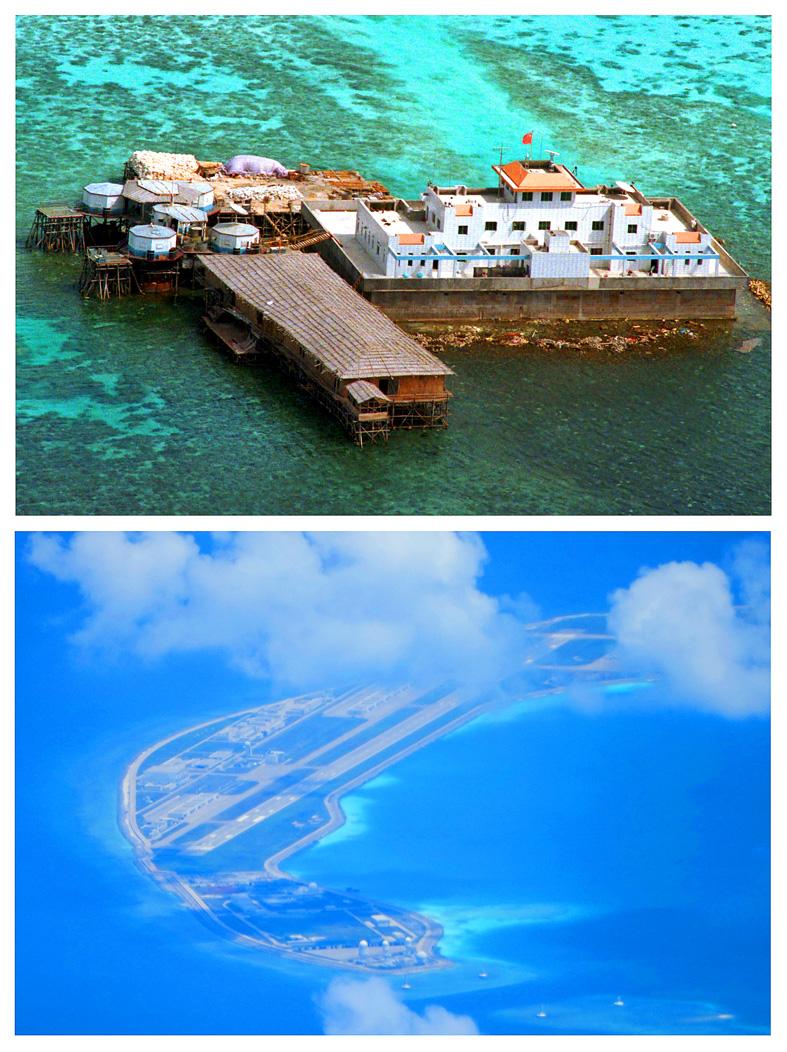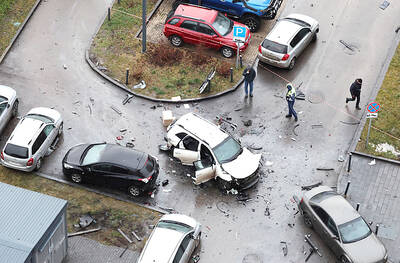China has fully militarized at least three of several islands it built up in the disputed South China Sea, arming them with anti-ship and anti-aircraft missile systems, laser and jamming equipment, and fighter jets in an increasingly aggressive move that threatens all nations operating nearby, a top US military commander said on Sunday.
US Indo-Pacific Commander Admiral John Aquilino said that the hostile actions were in stark contrast to Chinese President Xi Jinping’s (習近平) past assurances that Beijing would not transform the artificially enlarged islands in contested waters into military bases.
The efforts were the flexing of military muscle by the People’s Republic of China (PRC), he said.

Photo: AP
“I think over the past 20 years we’ve witnessed the largest military buildup since World War II by the PRC,” Aquilino told The Associated Press (AP) in an interview.
“They have advanced all their capabilities and that buildup of weaponization is destabilizing to the region,” Aquilino said.
There were no immediate comments from Chinese officials.
Beijing maintains its military profile is purely defensive, arranged to protect what it says are its sovereign rights.
Aquilino spoke with the AP onboard a US Navy reconnaissance aircraft that flew near Chinese-held outposts in the South China Sea’s Spratly Islands (Nansha Islands, 南沙群島), one of the most hotly contested regions in the world.
During the patrol, the P-8A Poseidon plane was repeatedly warned by Chinese callers that it had illegally entered what they said was China’s territory and ordered the plane to move away.
However, the US Navy plane dismissed the multiple warnings and pressed on defiantly with its reconnaissance in brief but tense moments witnessed by two AP journalists invited onboard.
“I am a sovereign, immune United States naval aircraft conducting lawful military activities beyond the national airspace of any coastal state,” the US pilot radioed back to the Chinese.
Aquilino said the construction of missile arsenals, aircraft hangars, radar systems and other military facilities on Mischief Reef (Meiji Reef, 美濟礁), Subi Reef (Jhubi Reef, 渚碧礁) and Fiery Cross Reef (Yongshu Reef, 永暑島) appeared to have been completed, but it remains to be seen whether China will pursue the construction of military infrastructure in other areas.
“The function of those islands is to expand the offensive capability of the PRC beyond their continental shores,” he said. “They can fly fighters, bombers plus all those offensive capabilities of missile systems.”
Washington’s main objective in the disputed region is “to prevent war” through deterrence, and promote peace and stability, including by engaging US allies and partners in projects with that objective, Aquilino said.
“Should deterrence fail, my second mission is to be prepared to fight and win,” said Aquilino, who leads the largest US combatant command with 380,000 military and civilian personnel covering 36 nations and territories.

A car bomb killed a senior Russian general in southern Moscow yesterday morning, the latest high-profile army figure to be blown up in a blast that came just hours after Russian and Ukrainian delegates held separate talks in Miami on a plan to end the war. Kyiv has not commented on the incident, but Russian investigators said they were probing whether the blast was “linked” to “Ukrainian special forces.” The attack was similar to other assassinations of generals and pro-war figures that have either been claimed, or are widely believed to have been orchestrated, by Ukraine. Russian Lieutenant General Fanil Sarvarov, 56, head

SAFETY FIRST: Double the number of police were deployed at the Taipei Marathon, while other cities released plans to bolster public event safety Authorities across Taiwan have stepped up security measures ahead of Christmas and New Year events, following a knife and smoke bomb attack in Taipei on Friday that left four people dead and 11 injured. In a bid to prevent potential copycat incidents, police deployments have been expanded for large gatherings, transport hubs, and other crowded public spaces, according to official statements from police and city authorities. Taipei Mayor Chiang Wan-an (蔣萬安) said the city has “comprehensively raised security readiness” in crowded areas, increased police deployments with armed officers, and intensified patrols during weekends and nighttime hours. For large-scale events, security checkpoints and explosives

PUBLIC SAFETY: The premier said that security would be tightened in transport hubs, while President Lai commended the public for their bravery The government is to deploy more police, including rapid response units, in crowded public areas to ensure a swift response to any threats, President William Lai (賴清德) said yesterday after a knife attack killed three people and injured 11 in Taipei the previous day. Lai made the remarks following a briefing by the National Police Agency on the progress of the investigation, saying that the attack underscored the importance of cooperation in public security between the central and local governments. The attack unfolded in the early evening on Friday around Taipei Main Station’s M7 exit and later near the Taipei MRT’s Zhongshan

REBUFFED: In response to Chinese criticism over recent arms sales, Washington urged Beijing to engage in meaningful dialogue instead of threats and intimidation Washington’s long-term commitment to Taiwan would not change, the US Department of State said yesterday, urging Beijing to stop pressuring Taiwan and engage in meaningful bilateral dialogues. The remarks came in response to a backlash from Beijing about Washington’s latest approval of arms sales to Taiwan. The US Defense Security Cooperation Agency said in a statement on Wednesday that the Taipei Economic and Cultural Representative Office in the US has asked to purchase an arms package, including Tactical Mission Network Software; AH-1W helicopter spare and repair parts; M109A7 self-propelled howitzers; HIMARS long range precision strike systems; tube-launched, optically tracked, wire-guided missiles; Javelin